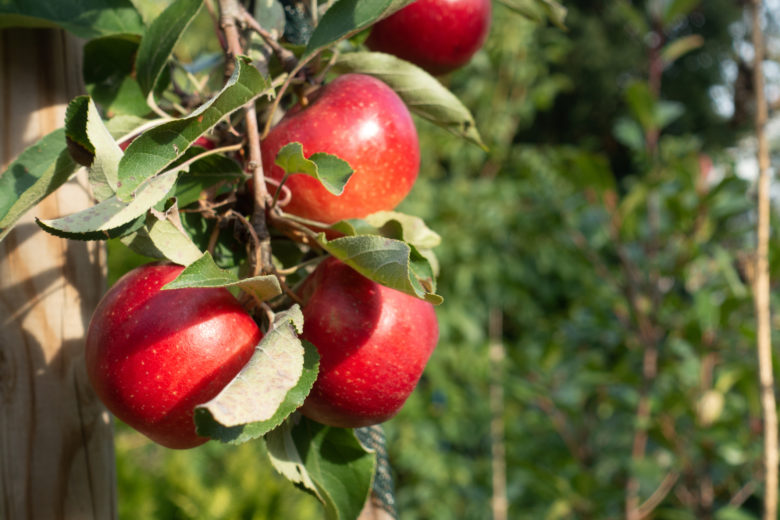
When Victoria M. Getty, MEd, RD, heard a proposal for the development of an urban orchard in Bloomington, Ind., she jumped at the chance to get involved. As director of the didactic program in dietetics at Indiana University and a senior lecturer, she knew the orchard could become a nutrition education resource for the community.
Five years later, the Bloomington Community Orchard is home to about 100 fruiting trees, vines, shrubs and brambles on just less than an acre. And Getty has orchestrated a fruitful partnership between the orchard and her classroom — her community nutrition students volunteer at the orchard or another garden-related organization at least twice during the semester.
“Dietetics majors have got to get their hands in the dirt,” says Getty. “It’s not going to color every counseling session they have, but I think everybody needs to understand where food comes from. You can’t just assume it shows up on grocery store shelves.”
The Bloomington Community Orchard is one of many urban orchards that have put down roots throughout the U.S. in recent years, encouraging community member participation. While they vary in location, fruits grown and scope, urban orchards often share the goals of promoting urban green spaces, connecting city residents to nature and growing accessible and healthful local food systems.
An Eco-friendly Initiative
Driven by the locavore movement and urban initiatives for greener cities, urban agriculture has taken off in recent years, using practices such as vertical farming to grow food on small parcels of land. Some urban agriculturalists consider urban orchards to be the next big thing, touting the environmental benefits of using urban land for fruit orchards over other crops.
Soil contamination, particularly by lead, is an ongoing concern for urban agriculturalists. While root vegetables and some leafy greens are more likely to absorb lead from contaminated soil, lead doesn’t concentrate in fruit (although because fruit still is susceptible to lead-contaminated dust or water in the urban environment, rinse it in water that contains 1 percent vinegar or 0.5 percent soap).
Through evapotranspiration and shade, urban tree cover cools cities and saves energy, which are major benefits for urban heat islands — metropolitan areas that are significantly warmer than nearby rural areas. Trees also improve air quality in part by absorbing gaseous pollutants and sequestering carbon dioxide in their branches, trunks and roots. Acting as sponges, trees reduce storm water runoff and slow the flow of polluted water while also cleaning it, according to the USDA Forest Service Urban and Community Forestry Program.
Reconnecting with Nature
Long a fixture in rural communities, orchards in cities connect urban residents to nature. Underlining a commitment to sustainability, University of Maryland students from the Public Health Garden Club in College Park began planting a 33-tree, on-campus orchard on Earth Day (April 22, 2015), including apples, Asian pears, figs, persimmons and almonds. The group intends to complete planting by fall 2016, says Carin Celebuski, coordinator of volunteers for the University of Maryland Arboretum and Botanical Garden.
“We hope the orchard will get our campus community members thinking about how fruits grow, where fruits come from, what edible fruits can be grown in our part of Maryland and the seasonality of local fruits,” says Celebuski. Back in Indiana, the Bloomington Community Orchard hosts two festivals each year to help citizens “get a sense of the rhythm of harvest,” says Amy Roche, outreach team leader for the orchard.
Studies show that connecting to green space has many mental health benefits along with communal ones. According to researchers at the Landscape and Human Health Laboratory at the University of Illinois at Urbana-Champaign, performing activities in green settings may help reduce children’s ADHD symptoms. Even just the sight of trees in a community may have positive health implications. A study conducted in a Chicago public housing development found girls who lived in apartments with more natural views exhibited better self-discipline than those living in identical housing without green space immediately within view.
Fresh Fruit for All
Urban orchards also provide city neighborhoods with a nutritious supply of fresh fruit. Established in 2007, the Philadelphia Orchard Project partners with schools, churches and community gardens to plant urban orchards and provide long-term operational support. The organization has planted 37 orchards in low-wealth neighborhoods across Philadelphia and supports 11 independently managed plantings. Once an orchard is planted, partners oversee the trees and disburse the harvests throughout their communities.
“Community partners actually own, maintain and harvest the fruits,” says executive director Phil Forsyth. “The idea is to return some control over food resources to neighborhoods [that are] considered food-insecure.” When applying, potential community partners have to explain how having an urban orchard in their community will contribute to food security. “Some of the food has to [reach] people who have otherwise limited access to fresh fruit,” he says.
The nonprofit model seems to be working: The vast majority of Philadelphia Orchard Project partners are in low-wealth neighborhoods and distribute fruit directly to the community through afterschool programs for kids and food donations at churches. Others serve as community gardens with open harvest, meaning people are free to pick whatever they like. The orchards in moderate-income neighborhoods distribute a percentage of the fruit they grow to food pantries.
The Philadelphia Orchard Project’s reach is deep: A survey of 41 of the 48 Philadelphia Orchard Project partners found that more than 2,000 people participated in orchard care in 2014. More than 2,500 people tasted something grown in one of the orchards in the past year, more than 3,700 individuals participated in education programs at an orchard and more than 4,100 people used orchards as gathering spaces. This is promising news for urban orchards still putting down roots in cities throughout the country.
